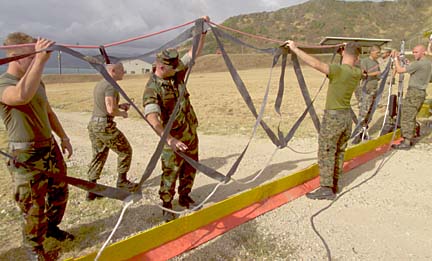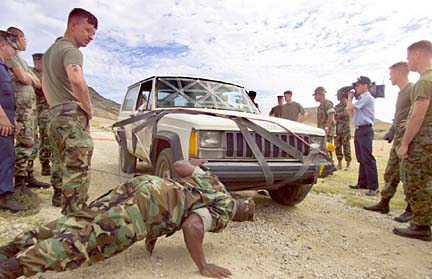
DENNIS ODA / DODA@STARBULLETIN.COM
Kaneohe Marines field-tested a portable barrier last week that is designed to stop trucks carrying terrorists and explosives. Here, Marines set up the webbing for the demonstration.
Military roadblock
weaves a tangled webKaneohe Marines test a device
that can safely stop a vehicle
traveling at 45 mph
The U.S. Army and the Marine Corps are field-testing a new portable vehicle barrier system to stop trucks that are suspected to be carrying terrorists and explosives.
"It's as simple as throwing a lasso and hog-tying the vehicle," said Frank Pratt, project manager with the Marine Corps Systems Command. "Once you get your lasso around the vehicle, the driver can't get out."
It also is part of the military's effort to develop nonlethal weapons to produce little or no permanent injuries when dealing with sensitive situations involving civilians, crowds and near riots.
The "lasso" that Pratt was referring to at a demonstration last week for the 3rd Marines at Kaneohe Bay is a 24-foot-long webbing that can be set up across any two-lane road as a temporary barrier.
When erected the barrier stands about 4 1/2 feet high and is about 8 to 12 inches off the ground.
Pratt said it is designed to stop a vehicle weighing up to 14,200 pounds traveling at 45 mph.
Generally it would be located about 300 feet away from a checkpoint or roadblock and would be the final security barrier on any post or installation.
DENNIS ODA / DODA@STARBULLETIN.COM
In a demonstration of the Marines' Portable Vehicle Arresting Barrier, a Jeep Cherokee going 35 mph was caught in the webbing, stopped and immobilized within 50 feet.
That means a driver would have had to slow down to maneuver through the first series of obstacles, which is generally barbed or concertina wire or concrete blocks, erected on any roadway leading to a military installation.
"Then if the terrorist decides to run through the remaining checkpoint," Pratt said, "all a sentry would have to do is push a button and two seconds later this barrier would pop up."
Pratt said that during the Iraqi war, two of these portable barrier systems were deployed with Marines stationed in Kuwait. However, he added, he didn't know if they were used.
The system can be installed on any roadway within two hours by a five-man crew. Re-setting the barrier is even easier, Pratt said, with past field tests showing it can be done in 30 minutes or less.
The entire system weighs 1,050 pounds and can be broken down to seven wooden crates, each weighing 150 pounds, so each box can be carried by two men. The system can be easily loaded onto one pallet for shipment by air or boat and can be carried by a single Humvee or 2 1/2 ton truck.
DENNIS ODA / DODA@STARBULLETIN.COM
The vehicle burned rubber trying to escape the mesh, but to no avail.
The barrier is laid out over the roadway out of sight, in a small box that vehicles can easily drive over when it is not in use. It is erected by air pressure from bottles, which can be refilled with a bicycle pump.
It was developed about five years ago after the Marine Corps was given the task of researching and making nonlethal weapons systems, Pratt said.
The first round produced 133 systems under a $34,865 appropriation. A second round produced 259 systems, with 53 given to the Marine Corps and the rest allocated to the Army. He said the Air Force also is interested in the system.
At last week's training session at Mokapu Crater firing range, Marines were taught the proper way to assemble and disassemble the system.
DENNIS ODA / DODA@STARBULLETIN.COM
A Marine inspected the barrier's webbing .
One of the road tests involved a white Jeep Cherokee that was traveling at 35 mph when it hit the barrier. It immediately stalled after the netting wrapped around the front bumper and got entangled around the vehicle's rear suspension.
"The MPs or the infantry can now rush and take control of the situation," said Mike Pellegrino, new equipment training officer with the Picatinny Arsenal who was instructing the Kaneohe Marines. "The driver is now rendered incoherent.
"He can't get away even if he tried backing up. He is hog-tied. He's tangled. He's dead."
Pellegrino then told the Jeep driver to back up his vehicle as if he were attempting a getaway. But the netting was wound around the Jeep's rear wheel, causing it to stop after moving about 50 feet.
Without this system, Pratt said, the only alternative to stopping a vehicle that tries to run through a checkpoint or a roadblock would be to shoot at it.
"This will stop any vehicle within 200 feet with minimal damage to the vehicle or its occupant."
Lt. Col. Danny Strand, Kaneohe's anti-terrorist officer, said he was impressed with the training and the demonstration.
"I think this gives us one more tool we can utilize in a nonlethal and safe way to stop a vehicle," Strand said. "The world has changed since 9/11. Terrorism is not going away. This is just one more tool we can use."



